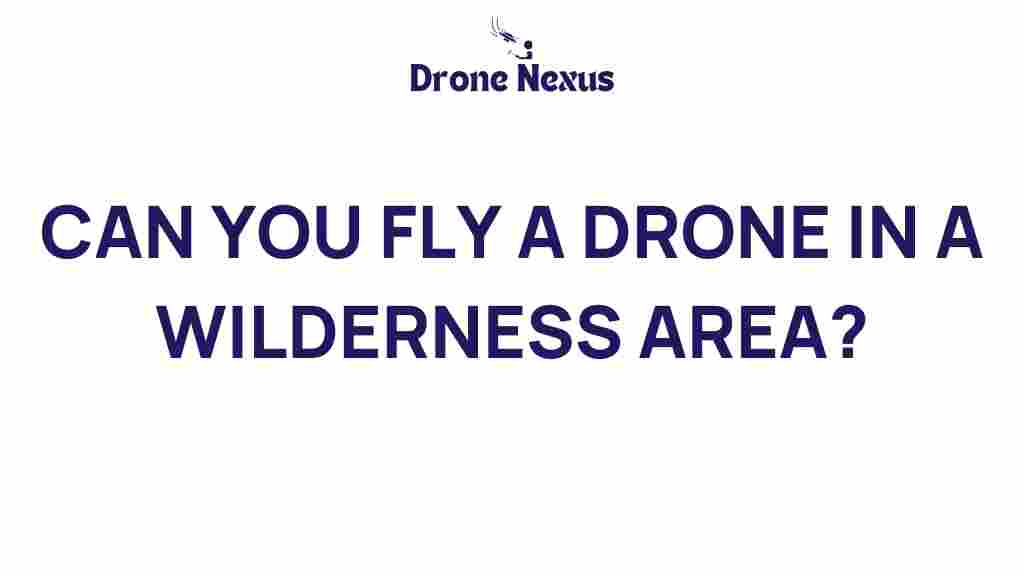Drone Regulations: Understanding the Legal Framework for Flying Drones in Wilderness Areas
The popularity of drones has soared in recent years, with hobbyists and professionals alike utilizing these versatile flying machines for various purposes. However, as drone usage increases, so do the questions surrounding the legalities of flying them, particularly in sensitive areas like wilderness zones. This article will guide you through the intricacies of drone regulations in wilderness areas, ensuring you understand what is permitted and what is prohibited.
What Are Wilderness Areas?
Wilderness areas are designated regions that are preserved in their natural condition, largely free from human influence. These areas are crucial for protecting wildlife, ecosystems, and providing opportunities for recreation and solitude. The U.S. Wilderness Act of 1964 set the framework for these areas, which are managed by various federal agencies, including:
- The U.S. Forest Service
- The Bureau of Land Management
- The National Park Service
- The U.S. Fish and Wildlife Service
Understanding Drone Regulations in Wilderness Areas
When it comes to flying drones in wilderness areas, specific regulations come into play. Understanding these drone regulations is essential for anyone considering taking their drone into the wild. Below are the primary factors to consider:
1. Federal Regulations
The Federal Aviation Administration (FAA) oversees all airspace in the United States, including drone operations. Here are key FAA regulations relevant to flying drones:
- Drones must be registered if they weigh more than 0.55 pounds.
- Drone pilots must adhere to the Part 107 regulations if they are flying for commercial purposes.
- Drone pilots must maintain a visual line of sight with their drone at all times.
- Flying above 400 feet is prohibited unless you are within 400 feet of a structure.
2. National Park Service Regulations
The National Park Service (NPS) has strict rules regarding drone use in national parks and wilderness areas. These regulations are designed to protect wildlife and preserve the natural landscape. Key points include:
- Drone use is generally prohibited in national parks.
- Special use permits may be available for specific activities but are rarely granted.
- Violating these regulations can result in fines and confiscation of equipment.
3. United States Forest Service Regulations
The U.S. Forest Service also regulates drone usage within wilderness areas. Their guidelines include:
- Drones are prohibited in designated wilderness areas.
- Drone use may be allowed in other parts of national forests, but specific permissions may be required.
- Always check with local forest service offices for the most accurate and updated regulations.
Step-by-Step Process: How to Legally Fly a Drone Near Wilderness Areas
If you are considering flying your drone near a wilderness area, follow this step-by-step guide to ensure compliance with all relevant drone regulations.
Step 1: Research Local Regulations
Before you even think about flying, research the specific drone regulations that apply to the area you plan to visit. This includes checking:
- FAA regulations for the airspace.
- National Park Service guidelines for any nearby parks.
- U.S. Forest Service rules for national forests and wilderness areas.
Step 2: Consider Your Purpose
Determine whether you will be flying for recreational or commercial purposes. The regulations can differ significantly between the two. If you’re flying commercially, ensure you have the necessary Part 107 certification from the FAA.
Step 3: Obtain Necessary Permits
If you plan to fly in areas where drone usage may be permitted, check if you need any special permits. This is particularly important in national parks and other protected lands where regulations are stringent.
Step 4: Check for Temporary Flight Restrictions (TFRs)
Before flying, always check for any Temporary Flight Restrictions (TFRs) that may be in effect. These can arise from various reasons, including natural disasters, special events, or military operations.
Step 5: Fly Responsibly
When it’s time to fly, always adhere to the following safety tips:
- Maintain visual line of sight with your drone.
- Be aware of your surroundings, including wildlife and other people.
- Avoid flying at night unless you have the proper equipment.
- Respect the privacy of others and do not invade their space.
Troubleshooting Tips for Drone Operation
Even with proper planning, issues can arise when flying a drone. Here are some troubleshooting tips to keep in mind:
1. Loss of Signal
If you lose connection with your drone, it may return to its last known location. Always ensure your drone has enough battery life and that you are within range.
2. GPS Issues
Sometimes, drones may struggle to acquire GPS signals, particularly in wooded or mountainous areas. If this occurs, consider flying in a more open space.
3. Weather Conditions
Wind and rain can severely impact drone performance. Always check the weather forecast and avoid flying in inclement weather.
4. Battery Life
Always monitor your drone’s battery life and bring extra batteries if you plan to fly for an extended period. It’s crucial to land before the battery runs out to avoid crashes.
Conclusion: The Importance of Complying with Drone Regulations
Flying a drone in or around wilderness areas requires a thorough understanding of the applicable drone regulations. By familiarizing yourself with federal and local laws, obtaining the necessary permits, and practicing responsible flying, you can enjoy the wonders of aerial photography or videography while respecting the natural environment.
For more information on drone regulations and safety tips, visit the FAA’s official website. If you’re looking for specific details on a wilderness area you’re interested in, check with the local forest service or park service offices. By taking these steps, you can ensure a safe and legal flying experience while enjoying the breathtaking beauty of the wilderness.
This article is in the category Safety and created by DroneNexus Team
